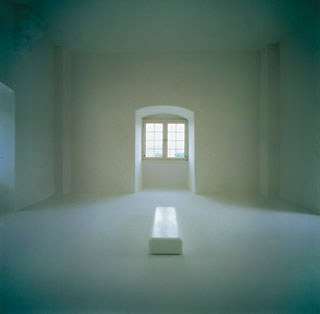|
| |
 |
|

|

The White Figure, 1990. Kavala marble, 7 7/8 x 17 11/16 x 66 15/16 inches. Courtesy Michael Werner Gallery, New York and Cologne.
|

Ranging from group actions and performances to installations and sculpture, the work of James Lee Byars resists neat categorization. During his formative years in Japan, Byars was attracted to Zen Buddhism and Noh theater and studied traditional Japanese ceramics and papermaking. Byars pursued the Zen notion of the ephemeral starting in a series of "performable sculptures" in the early 1960s, in which paper strips measuring as long as 1,000 feet were slowly unfolded in public performances. Later actions performed by Byars, such as launching a mile of gold thread with a helium balloon or kissing the air, point to his abiding interest in the transitory and fleeting.
In the late 1970s Byars began to create sculptures in durable materials. His sculptures use primary forms, such as the sphere and the cube, but unlike Donald Judd, Carl Andre, and other artists of his generation, Byars was interested in spiritual rather than phenomenological questions. In contrast to the Minimalists' austere industrial materials, which serve to call attention to the specificity and objecthood of their works, Byars employed precious materials such as gold and marble, with unblemished surfaces and soft, organic edges. Enigmatic works like The White Figure, first exhibited in an all-white chapel-like setting at Documenta IX in Kassel, Germany, reveal a striving for perfection and transcendence that is altogether alien to Minimalism.
|
|